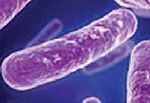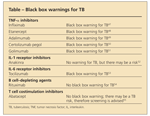Article
Latent Tuberculosis Infection in RA: The Disease and the Diagnosis
Reactivation of latent tuberculosis infection (LTBI) has emerged as a problem in patients with rheumatoid arthritis (RA). Anti–tumor necrosis factor α therapy is strongly associated with reactivation of tuberculosis (TB) in patients with RA.
ABSTRACT: Reactivation of latent tuberculosis infection (LTBI) has emerged as a problem in patients with rheumatoid arthritis (RA). Anti–tumor necrosis factor α therapy is strongly associated with reactivation of tuberculosis (TB) in patients with RA. However, RA itself has been associated with a higher incidence of TB. The current consensus is that patients with RA should be screened and, if necessary, treated for LTBI before the start of treatment for RA and monitored closely with yearly tests for TB. There is no gold standard for making the diagnosis. The tuberculin skin test (TST) is the traditional method. Two-step testing is useful for the initial skin testing of adults who will be retested periodically. The TST has several limitations. (J Musculoskel Med. 2011;28:249-253)
Reactivation of latent tuberculosis infection (LTBI) has emerged as a problem in patients with rheumatoid arthritis (RA), the result of the immune dysregulation associated with RA and the currently accepted therapeutic paradigm. The latter includes the use of disease-modifying antirheumatic drugs; corticosteroids; and most recently, biologic agents, now a mainstay of treatment for patients with RA.
Although tuberculosis (TB) was once considered a problem only in developing countries, it is now a growing concern in the developed world. Factors include rising immigration from countries in which there are high incidences of TB and HIV infection and that have an aging resident population as well as the increasing use of powerful immunosuppressants and immunomodulators in transplantation medicine and in the treatment of patients with immune-mediated inflammatory diseases (IMIDs).
In this 2-part article, we offer 20 “clinical pearls” to answer key questions about LTBI in patients with RA. This first part describes the traditional diagnostic tests and interpretation of their results. In the second part, to appear in an upcoming issue of this journal, we will discuss the newer diagnostic techniques, provide a review of the current literature, and describe the current guidelines for treatment and monitoring.
1. What is LTBI?

Figure
– Mycobacterium tuberculosis
bacilli, present in patients with latent tuberculosis infection, are seen in this electron micrograph
Persons with LTBI are infected with Mycobacterium tuberculosis (Figure) but are not clinically ill and have no symptoms or evidence of active TB. They have M tuberculosis organisms in their bodies that are alive but cannot spread TB infection to others. In these persons, findings on chest x-ray films are normal and sputum test results are negative for M tuberculosis, but they need treatment to prevent TB disease. Thus, eradication of TB is a realistic aim with treatment of LTBI in developed countries and in countries in which the prevalence of TB is low.1
2. What is the meaning of “remote TB infection”?
Is it different from “latent TB infection”?
“Remote infection” is an ill-defined term used sporadically in the TB community. Most experts agree it would refer to a previous TB infection that has been contained by the person’s immune system. However, some may interpret it as a previous TB infection that still carries some risk of reactivation. Remote TB infection is different from LTBI. M tuberculosis bacilli definitely are present in persons with LTBI.
3. Why is LTBI detection important in patients with RA?
Patients with RA have a 4-fold increased risk of TB infection compared with the general population2; therefore, they should be screened for LTBI regularly.1 Many patients with RA are treated long-term with corticosteroids (eg, 15 mg/d of prednisone for more than 1 month3). Studies associate corticosteroid use with an increased risk of LTBI activation to TB.4,5
Anti–tumor necrosis factor α (anti–TNF-α) therapy is strongly associated with reactivation of TB in patients with RA.4-6 Therefore, LTBI should be screened for and, if present, managed in all patients with RA for whom treatment with anti–TNF-α agents is to be started.7-10 Most cases of TB in patients who are receiving immunosuppressive therapy have been attributed to reactivation of TB infection.6,11,12 Overall, active TB disease develops in about 5% to 10% of patients with LTBI at some time in their lives.13-16 In about half of persons in whom active TB develops, it does so within the first 2 years of infection.
4. Which of the current biologic agents for RA require screening for LTBI?
TABLE

Black box warnings for TB
Several agents carry black box warnings for TB. Specific agents are listed in the Table.
5. What is the role of anti–TNF-α treatment for RA in TB reactivation?
Numerous reports have been published on TB reactivation after administration of anti–TNF-α agents.4,9,17-31 Some of the reactivation cases have proved to be fatal. However, RA itself has been associated with a higher incidence of TB independent of anti–TNF-α treatment, possibly because of the underlying immune dysfunction in RA.
A few experts have gone even further and argued that anti–TNF-α therapy does not increase the risk of TB over and above the risk inherently associated with RA.2,4,26 However, the current consensus is that patients with RA should be screened and, if necessary, treated for LTBI before the start of treatment for RA-especially with biologic agents-and monitored closely with yearly tests for TB according to the guidelines discussed below.
6. How does a clinician make a diagnosis of LTBI?
There is no gold standard for diagnosis. Definitive diagnosis of LTBI is based on information gathered from the medical history, tuberculin skin test (TST) or Interferon-Gamma Release Assay (IGRA) results, chest radiography, physical examination and, in some circumstances, sputum examinations.
Risk factors associated with previous exposure to M tuberculosis need to be assessed for a clinical diagnosis.32,33 Radiographic features regarded as suggestive of previous TB infection also must be noted; they include apical pleural thickening, pulmonary nodules, upper lobe bronchiectasis, interstitial granulomatous calcification, cavitation, and lymph node or pericardial cacification.34 Be sure to rule out active TB before labeling a patient as having LTBI.34
7. What are the traditional methods of LTBI diagnosis?
Besides the history and examination described above, the TST is the traditional method for making the diagnosis. Introduced by von Pirquet in 1907, the TST is the oldest diagnostic test for TB.35,36 The TST measures type IV hypersensitivity in response to purified protein derivative (PPD), which contains a mixture of antigens of M tuberculosis;Mycobacterium bovis; and other, nontuberculous mycobacteria.35-37
The Mantoux technique is administered by injecting 0.1 mL of 5 tuberculin units (TU) of PPD intradermally into the dorsal or volar surface of the patient’s forearm. Tests should be read 48 to 72 hours after administration. Induration, not erythema, should be recorded; the transverse diameter of induration should be recorded in millimeters.
Multiple puncture tests (ie, Tine and Heaf) and PPD strengths of 1 TU and 250 TU are not sufficiently accurate and should not be used.34 However, the TST is used widely because there is evidence that treatment of patients with LTBI after a diagnosis made with the TST reduces the risk of active TB infection by 60%.14,34 TST results should be interpreted by trained personnel 48 to 72 hours after test administration.
A TST reaction of 5 mm or more of induration is considered a positive result in patients with RA3 and patients with IMIDs who make significant use of corticosteroids (eg, the equivalent of 15 mg/d or more of prednisone for 1 month), are receiving anti–TNF-α antagonists, or are immunocompromised. A TST reaction of 10 mm or more of induration is considered a positive result in hospital staff and adults exposed to adults at high risk for TB disease. A TST reaction of 15 mm or more of induration is considered a positive result in persons who have no known risk factors for TB.
8. What is a “booster” response of the TST?
For some patients infected with M tuberculosis, the ability to react to tuberculin may wane over time. When they are given a TST years after the infection, they may have a false-negative result. However, this first TST may stimulate the immune system, causing a positive, or “boosted,” reaction to subsequent tests because of recall of immunity.
Therefore, 2-step testing-giving a second TST 1 to 3 weeks after a negative TST reaction-is useful for the initial skin testing of adults who will be retested periodically, such as health care workers and nursing home residents. This 2-step approach can reduce the chances of a boosted reaction to a subsequent TST being misinterpreted as a recent infection.
The booster response is less specific for the diagnosis of LTBI than the initial TST result because the booster response may be caused by previous BCG vaccination, sensitization to nontuberculous mycobacteria, or remote TB infection. Therefore, the risk of active TB among persons with a booster response (a positive result on a TST performed 1 to 4 weeks after an initial negative TST result in the absence of exposure) is lower than the risk of active TB among persons with an initial positive TST result.38
9. What are the limitations of the TST?
Patients with RA who are treated with anti–TNF-α agents are at significant risk for TB reactivation.11,39,40 Even patients with RA who are not being treated with biologic agents are at higher risk.2,4 Therefore, screening for LTBI is important in patients with RA and should be done as early as possible, ideally at the time of RA diagnosis. The limitations of the TST include the following:
•Persons who have a history of a positive reaction to TSTs should not be retested even after full LTBI treatment because the TST result would not become negative again.34
•There are a lot of false-negative TST results in patients with RA, especially those who are receiving immunosuppressive medications and those who have a natural waning of immunity.
•The TST cannot distinguish between current infection and past resolved infection. Therefore, it has no role for patients with RA who already have been treated for LTBI, because it would not be helpful in detecting a new infection.
•Two patient visits to the health care facility are required,35 which may lead to adherence problems.
•Because test reading is subject to human error,35,41 standardization is lacking.
•A TST result may be affected by a previous BCG vaccination and the immune status of the person tested.42-45 The sensitivity may be low in patients with RA because of RA's immune-mediated pathogenesis14,35,37,41 or the medications used. There also may be lower specificity because of cross-reactivity with nontuberculous mycobacterial infection.14,36,37,41,46
•Some patients may not react to the TST even though they are infected with M tuberculosis. Possible reasons include cutaneous anergy (the inability to react to skin tests because of a dysfunctional immune system) and active infections, including TB and viral infections.34
•Vaccination with live viruses may interfere with TST reactions. For persons who are scheduled to receive a TST, testing should be done on the same day as the vaccination with live virus vaccine or 4 to 6 weeks afterward.
•In some patients, allergic reactions may occur because of immediate hypersensitivity wheal-and-flare response within 20 minutes of TST placement. The TST should not be repeated in these patients.
In spite of its limitations, the TST is used widely because it is relatively inexpensive. It also can be performed easily in the absence of clinical laboratory testing.
References:
References
1. American Lung Association of Washington. Diagnosis and Treatment of Latent Tuberculosis Infection (LTBI). Practice Guidance from the Washington TB Advisory Council. http://www.alaw.org/pdfs/tb_TTT-LTBInotes.pdf. Accessed June 6, 2011.
2. Carmona L, Hernández-GarcÃa C, Vadillo C, et al; EMECAR Study Group. Increased risk of tuberculosis in patients with rheumatoid arthritis. J Rheumatol. 2003;30:1436-1439.
3. Latent Tuberculosis Infection: A Guide for Primary Health Care Providers. Diagnosis of Latent TB Infection. Centers for Disease Control and Prevention. http://www.cdc.gov/tb/publications/LTBI/appendixA.htm. Accessed June 6, 2011.
4. Keane J, Gershon S, Wise RP, et al. Tuberculosis associated with infliximab, a tumor necrosis factor alpha-neutralizing agent. N Engl J Med. 2001;345:1098-1104.
5. Gòmez-Reino JJ, Carmona L, Angel Descalzo M; Biobadaser Group. Risk of tuberculosis in patients treated with tumor necrosis factor antagonists due to incomplete prevention of reactivation of latent infection. Arthritis Rheum. 2007;57:756-761.
6. Wolfe F, Michaud K, Anderson J, Urbansky K. Tuberculosis infection in patients with rheumatoid arthritis and the effect of infliximab therapy. Arthritis Rheum. 2004;50:372-379.
7. Mazurek GH, Jereb J, Lobue P, et al; Division of Tuberculosis Elimination, National Center for HIV, STD, and TB Prevention, Centers for Disease Control and Prevention. Guidelines for using the QuantiFERON-TB Gold test for detecting Mycobacterium tuberculosis infection, United States [published correction appears in MMWR Morb Mortal Wkly Rep. 2005;54:1288]. MMWR Recomm Rep. 2005;54(RR-15):49-55.
8. Keane J. TNF-blocking agents and tuberculosis: new drugs illuminate an old topic. Rheumatology (Oxford). 2005;44:714-720.
9. Provenzano G, Ferrante MC, Simon G. TB screening and anti-TNF alpha treatment. Thorax. 2005;60:613.
10. British Thoracic Society Standards of Care Committee. BTS recommendations for assessing risk and for managing Mycobacterium tuberculosis infection and disease in patients due to start anti-TNF-alpha treatment. Thorax. 2005;60:800-805.
11. Winthrop KL, Siegel JN, Jereb J, et al. Tuberculosis associated with therapy against tumor necrosis factor alpha. Arthritis Rheum. 2005;52:2968-2974.
12. Wallis RS, Broder MS, Wong JY, et al. Granulomatous infectious diseases associated with tumor necrosis factor antagonists. Clin Infect Dis. 2004;38:1261-1265.
13. Stewart GR, Robertson BD, Young DB. Tuberculosis: a problem with persistence. Nat Rev Microbiol. 2003;1:97-105.
14. Jasmer RM, Nahid P, Hopewell PC. Clinical practice: latent tuberculosis infection. N Engl J Med. 2002;347:1860-1866.
15. Tufariello JM, Chan J, Flynn JL. Latent tuberculosis: mechanisms of host and bacillus that contribute to persistent infection. Lancet Infect Dis. 2003;3:578-590.
16. Styblo K. Recent advances in epidemiological research in tuberculosis. Adv Tuberc Res. 1980;20:1-63.
17. Mayordomo L, Marenco JL, Gomez-Mateos J, Rejon E. Pulmonary miliary tuberculosis in a patient with anti-TNF-alpha treatment. Scand J Rheumatol. 2002;31:44-45.
18. Wagner TE, Huseby ES, Huseby JS. Exacerbation of Mycobacterium tuberculosis enteritis masquerading as Crohn’s disease after treatment with a tumor necrosis factor-alpha inhibitor. Am J Med. 2002;112:67-69.
19. Liberopoulos EN, Drosos AA, Elisaf MS. Exacerbation of tuberculosis enteritis after treatment with infliximab. Am J Med. 2002;113:615.
20. Vonkeman HE, van der Valk PD, Mulder L, van de Laar MA. Fatal miliary tuberculosis during treatment with infliximab [in Dutch]. Ned Tijdschr Geneeskd. 2002;146:1196-1199.
21. Roth S, Delmont E, Heudier P, et al. Anti-TNF alpha monoclonal antibodies (infliximab) and tuberculosis: apropos of 3 cases [in French]. Rev Med Interne. 2002;23:312-316.
22. Rovere Querini P, Vecellio M, Sabbadini MG, Ciboddo G. Miliary tuberculosis after biological therapy for rheumatoid arthritis. Rheumatology (Oxford). 2002;41:231.
23. Lim WS, Powell RJ, Johnston ID. Tuberculosis and treatment with infliximab. N Engl J Med. 2002;346:623-626.
24. Takasaka N, Toyota E, Shimada M, et al. Two cases of tuberculosis after treatment of rheumatoid arthritis with infliximab [in Japanese]. Nihon Kokyuki Gakkai Zasshi. 2010;48:60-65.
25. Elbek O, Uyar M, Aydin N, et al. Increased risk of tuberculosis in patients treated with antitumor necrosis factor alpha. Clin Rheumatol. 2009;28:421-426.
26. Mohan AK, Coté TR, Block JA, et al. Tuberculosis following the use of etanercept, a tumor necrosis factor inhibitor. Clin Infect Dis. 2004;39:295-299.
27. Tam LS, Leung CC, Ying SK, et al. Risk of tuberculosis in patients with rheumatoid arthritis in Hong Kong-the role of TNF blockers in an area of high tuberculosis burden. Clin Exp Rheumatol. 2010;28:679-685.
28. Brassard P, Kezouh A, Suissa S. Antirheumatic drugs and the risk of tuberculosis. Clin Infect Dis. 2006;43:717-722.
29. Park JH, Seo GY, Lee JS, et al. Positive conversion of tuberculin skin test and performance of interferon release assay to detect hidden tuberculosis infection during anti-tumor necrosis factor agent trial. J Rheumatol. 2009;36:2158-2163.
30. Dixon WG, Hyrich KL, Watson KD, et al; BSRBR Control Centre Consortium; BSR Biologics Register. Drug-specific risk of tuberculosis in patients with rheumatoid arthritis treated with anti-TNF therapy: results from the British Society for Rheumatology Biologics Register (BSRBR). Ann Rheum Dis. 2010;69:522-528.
31. Barouta G, Karapetsa M, Kostopoulou E, et al. Oral tuberculosis in a patient with rheumatoid arthritis after long treatment with methotrexate and adalimumab. J Clin Rheumatol. 2010;16:330-331.
32. Furst DE, Keystone EC, Kirkham B, et al. Updated consensus statement on biological agents for the treatment of rheumatic diseases, 2008 [published correction appears in Ann Rheum Dis. 2009;68:452]. Ann Rheum Dis. 2008;67(suppl 3):iii2-iii25.
33. Keane J, Bresnihan B. Tuberculosis reactivation during immunosuppressive therapy in rheumatic diseases: diagnostic and therapeutic strategies. Curr Opin Rheumatol. 2008;20:443-449.
34. Targeted tuberculin testing and treatment of latent tuberculosis infection. This official statement of the American Thoracic Society was adopted by the ATS Board of Directors, July 1999. This is a Joint Statement of the American Thoracic Society (ATS) and the Centers for Disease Control and Prevention (CDC). This statement was endorsed by the Council of the Infectious Diseases Society of America. (IDSA), September 1999, and the sections of this statement. Am J Respir Crit Care Med. 2000;161(4, pt 2):S221-S247.
35. Huebner RE, Schein MF, Bass JB Jr. The tuberculin skin test. Clin Infect Dis. 1993;17:968-975.
36. Lee E, Holzman RS. Evolution and current use of the tuberculin test. Clin Infect Dis. 2002;34:365-370.
37. Andersen P, Munk ME, Pollock JM, Doherty TM. Specific immune-based diagnosis of tuberculosis. Lancet. 2000;356:1099-1104.
38. Stead WW, To T, Harrison RW, Abraham JH 3rd. Benefit-risk considerations in preventive treatment for tuberculosis in elderly persons. Ann Intern Med. 1987;107:843-845.
39. Seong SS, Choi CB, Woo JH, et al. Incidence of tuberculosis in Korean patients with rheumatoid arthritis (RA): effects of RA itself and of tumor necrosis factor blockers. J Rheumatol. 2007;34:706-711.
40. Askling J, Fored CM, Brandt L, et al. Risk and case characteristics of tuberculosis in rheumatoid arthritis associated with tumor necrosis factor antagonists in Sweden. Arthritis Rheum. 2005;52:1986-1992.
41. American Thoracic Society; Centers for Disease Control and Prevention; Infectious Diseases Society of America. American Thoracic Society/Centers for Disease Control and Prevention/Infectious Diseases Society of America: controlling tuberculosis in the United States. Am J Respir Crit Care Med. 2005;172:1169-1227.
42. Helliwell MG, Panayi GS, Unger A. Delayed cutaneous hypersensitivity in rheumatoid arthritis: the influence of nutrition and drug therapy. Clin Rheumatol. 1984;3:39-45.
43. Ponce de Leòn D, Acevedo-Vásquez E, Sánchez-Torres A, et al. Attenuated response to purified protein derivative in patients with rheumatoid arthritis: study in a population with a high prevalence of tuberculosis. Ann Rheum Dis. 2005;64:1360-1361.
44. Paimela L, Johansson-Stephansson EA, Koskimies S, Leirisalo-Repo M. Depressed cutaneous cell-mediated immunity in early rheumatoid arthritis. Clin Exp Rheumatol. 1990;8:433-437.
45. Smith MD, Smith A, O’Donnell J, et al. Impaired delayed type cutaneous hypersensitivity in rheumatoid arthritis reversed by chrysotherapy. Ann Rheum Dis. 1989;48:108-113.
46. Wang L, Turner MO, Elwood RK, et al. A meta-analysis of the effect of Bacille Calmette Guérin vaccination on tuberculin skin test measurements [published correction appears in Thorax. 2003;58:188]. Thorax. 2002;57:804-809.
47. US Food and Drug Administration. Remicade (infliximab)-Black Box Warning. Safety Alerts for Human Medical Products. http://www.fda.gov/SafetyMedWatch/SafetyInformation/SafetyAlertsforHumanMedicalProducts/ucm172751.htm. Accessed June 6, 2011.
48. US Food and Drug Administration. Enbrel (etanercept). Safety Alerts for Human Medical Products. http://www.fda.gov/Safety/MedWatch/SafetyInformation/SafetyAlertsforHumanMedicalProducts/ucm085307.htm. Accessed June 6, 2011.
49. Abbott Laboratories. Humira (adalimumab). http://www.fda.gov/downloads/Drugs/DevelopmentApprovalProcess/HowDrugsareDevelopedandApproved/
ApprovalApplications/TherapeuticBiologicApplications/ucm092762.pdf. Accessed June 6, 2011.
50. US Food and Drug Administration. Cimzia (certolizumab pegol). Safety Alerts for Human Medical Products. http://www.fda.gov/Safety/MedWatch/SafetyInformation/ucm194120.htm. Accessed June 6, 2011.
51. US Food and Drug Administration. Simponi (golimumab). Safety Alerts for Human Medical Products. http://www.fda.gov/Safety/MedWatch/SafetyInformation/ucm194137.htm. Accessed June 6, 2011.
52. Amgen. Kineret (anakinra). http://www.fda.gov/downloads/Drugs/DevelopmentApprovalProcess/HowDrugsareDevelopedandApproved/Approval Applications/TherapeuticBiologicApplications/ucm094403.pdf. Accessed June 6, 2011.
53. Genentech, Inc. Actemra (tocilizumab). http://www.gene.com/gene/products/information/actemra/pdf/pi.pdf. Accessed June 6, 2011.
54. Biogen Idec Inc; Genentech, Inc. Rituxan (rituximab). http://patient.cancerconsultants.com/druginserts/Rituximab.pdf. Accessed June 6, 2011.
55. Bristol-Myers Squibb. Orencia (abatacept). http://packageinserts.bms.com/pi/pi_orencia.pdf. Accessed June 6, 2011.




